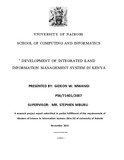Location
Our Vision is to be a world-class university committed to scholarly excellence.
Our Mission is to provide quality university education and training and to embody the aspirations of the Kenyan people and the global community through creation, preservation, integration, transmission and utilization of knowledge.
Core Values
In order to realize the above vision and mission, certain shared values shall be nurtured. There is great need for the University to be guided by the right values derived from the virtues and moral standards of the Kenyan and wider society.
Core Functions
Teaching and Learning: The university offers innovative , relevant and market driven academic programmes , both at undergraduate and postgraduate levels with inbuilt quality control systems the university also provides an environment and policy framework for undertaking high quality and relevant research
Members:
Resources
Displaying 116 - 120 of 298Development of integrated land information management system in Kenya
Land is a key asset of any country. It is one of the factors of production which includes labour
and capital. It is critical for economic, social and political development of a country. There exists
a correlation between proper utilization of land and the economic advancement of a country and
its proper management can only be achieved if information on the said land is available. The
current globalization trend in the world, demand for efficient and effective land services requires
Different land use types in the semi-arid rangelands of Kenya influence soil properties
Rangelands in semi-arid Kenya have recently witnessed extensive land use changes. These changes
can mainly be attributed to increased livestock populations and the response of the increased human
population to both local and exogenous opportunities and constraints. This study was carried out in
Kibwezi district of Kenya mainly inhabited by agro-pastoralists. The main objective of this study was to
establish how different land use types influence soil properties in tropical semi-arid rangelands.
Pathways to Real Access to Land-Related Resources for Women: Challenging and Overturning Dominant Legal Paradigms
The Desert Margins Programme Approaches in Upscaling Best-Bet Technologies in Arid and Semi-arid Lands in Kenya
Kenya’s land surface is primarily arid and semi-arid lands (ASALs) which account for 84% of the total land area. The Desert Margins Programme (DMP) in Kenya has made some contribution to understanding which technology options have potential in reducing land degradation in marginal areas and conserving biodiversity through demonstrations, testing of the most promising natural resource management options, developing sustainable alternative livelihoods and policy guidelines, and replicating successful models.
Abundance And Diversity Of Soil Mites (acari) Along A Gradient Of Land Use Types In Taita Taveta, Kenya
The abundance and diversity of soil mites was monitored along a gradient of land use types (LUTs) during the wet seasons in soils of Taita Taveta, Kenya. Sampling of mites from soils was carried out in eight LUTs which included maize-based system (Zea mays), coffee (Coffea Arabica), horticulture, napier grass (Pennisetum purpureum), fallow, pine (Pinus patula), cypress (Cypressus lusitanica), natural forest.






